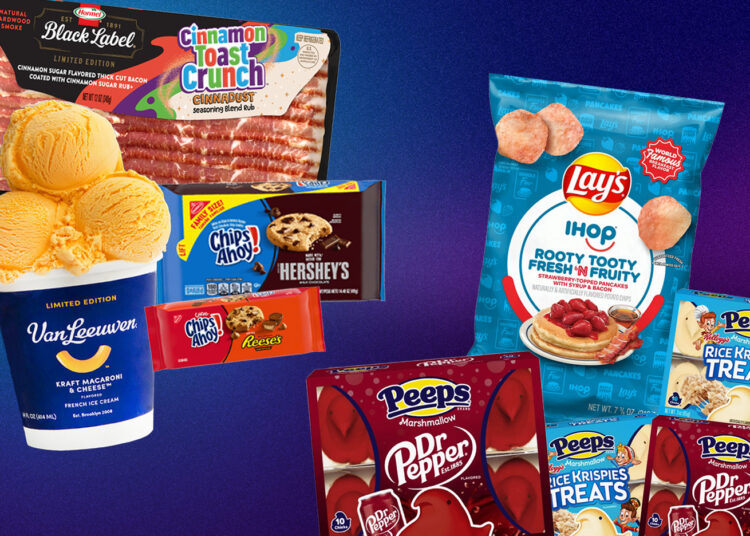Lille Allen
Who are all these wacky brand collaborations for?
It was about the time that I saw the Coca-Cola Oreo flavor that I thought, Enough. Oreo has gotten a reputation for overdoing it on flavor innovations — peanut butter? Fine. Sour Patch Kids? Leave me alone — but something about Coca-Cola Oreos, and the corresponding Coca-Cola Zero Sugar Oreo soda, made me feel like I was putting on the They Live glasses, seeing every item on the grocery shelf for the crude marketing ploy it is. What a blatant money grab, I thought. Who even wants these?
According to retail company THG, which primarily sells cosmetics and dietary supplements online, brands across the board have been increasingly collaborating on products to reach different markets. In food, this means all the snacks look like they were run through the Large Hadron Collider. There’s Peeps Pepsi and Dr Pepper Peeps. Van Leeuwen teamed up with Kraft Mac and Cheese and Hidden Valley Ranch to make ice cream. IHOP and Lay’s teamed up for Rooty Tooty Fresh ’N Fruity chips. There’s Reese’s and also Hershey’s Chips Ahoy! Hormel and Cinnamon Toast Crunch made bacon. And every PepsiCo product, from Funyuns to Smartfood to Ruffles, has a Flamin’ Hot variety.
These “shock flavors” serve one purpose — to get the customer to buy “one more,” says Russell Zwanka, the director of Western Michigan University’s food marketing program. “Releasing a new product that is not a shock flavor is based upon research and development and whatever the customer is looking for,” he says. But something like Apple Jacks Pop-Tarts isn’t about giving the customers what they want. It’s about leveraging brand recognition, a scattershot form of chasing sales, focused on the thrill of trying something new and in all likelihood gross. It’s a dare from the grocery aisle — “Eww, taste this” — with a nutrition facts label.
“What you find is there’s safety in buying the one that you would always buy, and then you pick up the new one,” says Zwanka. “Essentially, you have doubled [a consumer’s] order.” These collaborations work particularly well with food and drinks, because while buying Flamin’ Hot Mountain Dew is a risk (mostly to your stomach lining), it’s a low-lift risk. A Sour Patch Kids BMW would be too much to spend your money on for pure curiosity, “but a $2.99 Oreo, if you don’t like it, you just move on.” And most of these collaborations are available for a limited time, which further pressures shoppers to pick up something ridiculous that they may never get to try again.
As with restaurant collaborations, in which two restaurants team up on a one-night-only menu that straddles each’s strong suits, these products are intended to boost both brands. A Sour Patch Kids fan who may not usually like Oreos may be tempted to try this version, while an Oreo fan may be reminded they also like Sour Patch Kids. “You had a touch point, you had an interaction with a brand that you might not have had for the last five years,” says Zwanka. The collaboration may run its course, but next time you’re shopping, maybe you’ll pick up a bag of Sour Patch Kids for the first time in a while.
But crucially, these collaborations also exist because it’s easier than ever to create them. Oreo and Sour Patch Kids are both owned by Mondelez International, which was created in 2012 out of Kraft Foods’ snack division. In 2015, Kraft Foods Group, which had retained the company’s grocery items, merged with the H.J. Heinz Company to form Kraft Heinz Company, which owns brands like Oscar Mayer, Philadelphia cream cheese, Kraft Mac and Cheese, and Jell-O. PepsiCo owns brands as disparate as Gatorade and Quaker Oats. What appears in the aisles like two brands coming together for a limited time is often a matter of shuffling resources around in one company. It’s very easy to make a Flamin’ Hot Funyun when you own both Cheetos and Funyuns — as well as Lay’s, Ruffles, Sun Chips, Smartfood, Tostitos, and Doritos.
Perhaps the glut of collaborations is a natural side effect of the “line goes up forever” expectation of modern business. It is not enough to provide a good product to the people who want it and sustain business on that. There always has to be something new, be it an acquisition or a collaboration, that makes the company bigger.
But of course, nothing grows forever, and while the snack sector in general is bringing in profits — net revenue at Kraft Heinz, Mondelez International, and PepsiCo are up — PepsiCo has reported that sales of Frito-Lay snacks are “subdued,” due to customers being ever more conscious of how much they’re spending at the grocery store. The company has raised prices on snacks every quarter for two years, and a novelty chip, once a thoughtless addition to the cart, is now a bigger chunk of the week’s food budget.
Still, Zwanka doesn’t believe consumers will grow fatigued by the flood of brand collaborations, because “as humans, we love new.” But as the trend continues, and the obvious pairings have already been done, the collaborations that are left are sure to become weirder and weirder. Maybe that’ll make shoppers so curious they need to readjust their spending to try them, or maybe they’ll become so weird that no one wants to take even a low-level risk. Can’t wait for Oscar Mayer Jell-O to hit the shelves.














